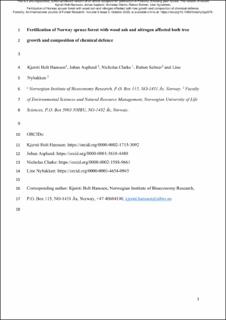| dc.description.abstract | We fertilized a Norway spruce (Picea abies (L.) Karst.) stand on rich mineral soil with 3 t ha−1 of wood ash (ASH), 150 kg ha−1 of nitrogen (N) or a combination of wood ash and nitrogen (ASH + N), in addition to unfertilized control plots. After five growing seasons, we remeasured the trees and took core samples. Current- and previousyear needles were sampled and analyzed for total nitrogen and carbon, low-molecular weight phenolics and condensed tannins. Annual volume increment and standing volume were significantly higher in the ASH + N treatment than in control plots after 5 years. N gave a significant positive effect on basal area growth in the third year, after which the effect diminished. The ASH + N treated trees, on the other hand, showed an increasing basal area growth trend throughout the period. ASH reduced the total concentration of low-molecular weight phenolic compounds significantly in current-year needles. Phenolic acids increased under both ASH and ASH + N, while flavonoids decreased significantly under the same treatments compared to N. By including annual growth rate before fertilization in the analyses, the effect of N-treatment on flavonoids was positive only in trees with higher growth rates, and in those trees the concentration was higher than in both ASH-treated plots and controls. An acetophenone, constituting more than half of the total low-molecular weight phenolics concentration, was strongly reduced under all fertilization treatments. These results demonstrate that in addition to effects on tree growth, fertilization of the forest floor also has a strong influence on other metabolic processes of trees, with potential implications for ecosystem functioning. | |
